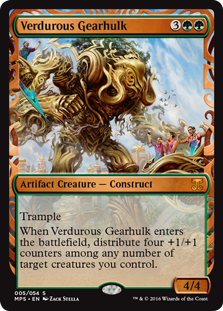Gearhulk or Grafwidow?

Should Verdurous Gearhulk unseat Ishkanah, Grafwidow at the Delirium five?
One of the three principal decks of Kaladesh Standard is B/G Delirium. There are at least two versions: Although they have a fair number of cards in common — Traverse the Ulvenwald; Grasp of Darkness; or Liliana, the Last Hope — the two builds have very different strategies and play patterns, and try to accomplish different things.
The incumbent version is more midrange. It is more likely to play both offense and defense at the same time with Sylvan Advocate. It might block with Ishkanah, Grafwidow in order to buy time to find a bullet Emrakul, the Promised End.
The newer version — tracing back to Eric Froehlich at Pro Tour Kaladesh — is more offensive. It plays Servant of the Conduit to get the jump on the opponent and is more likely to buff with Blossoming Defense than trade one-for-one with removal or disruption (though it might).
The case for Ishkanah, Grafwidow
Ishkanah, Grafwidow is a powerful card. We’ve seen it played in Temur decks that could never tap for black mana!
If you want to play a card that will help lock down the battlefield, there are few better options in Standard. Given time, it can cut down the opponent’s life total without having to risk combmat. Because it has reach, Ishkanah can help contain cards like Spell Queller or Archangel Avacyn. Because it has so many bodies, Ishkanah can act as a “go wide” stop sign to buy vital setup and stabilization time against beatdown.
The case for Verdurous Gearhulk
If you want to race or brawl, choose Verdurous Gearhulk. In the right context, Verdurous Gearhulk simply out-classes Ishkanah heads up. It will often be competitive (especially depending on what creature gets +1/+1 counters) but is always better when the opponent doesn’t yet have Delirium. Here, Servant of the Conduit and Catacomb Sifter help cast the Gearhulk ahead of time, and something to attack with.
For sure the best playmate to Verduous Gearhulk is Kalitas, Traitor of Ghet. Talk about big life swings! (Also Kalitas auto-ruins the lives of many opponents, e.g. B/R Zombies.)
Bonus: Using Traverse the Ulvenwald
Traverse the Ulvenwald is one of the most flexible cards in Standard. It is generally great for fixing your land draw on turn one, but cashing in for a real threat later in the game. Traverse the Ulvenwald is so effective for its cost it has even started to see adoption in Modern creature decks!
In the traditional Delirium strategies, you could Traverse on turn one (and the mana bases deliberately accommodate for having an extra few lands by playing only 23)… But once you have Delirium it can get an Ishkanah late, or a [generally singleton] Noxious Gearhulk as a point removal-type answer, or go super big with Emrakul.
In the EFro version, though, Traverse the Ulvenwald is more a way to get Delirium! The aggro version simply doesn’t have many sorceries, so a cheap [one mana] way to get a sorcery into the graveyard puts the deck 25% of the way to its namesake. Traverse the Ulvenwald is therefore generally less powerful and flexible in the aggro version of Delirium, but that might make sense, given that the games are shorter by design.
Listen now for more on B/G Delirium and a host of other Standard topics:

